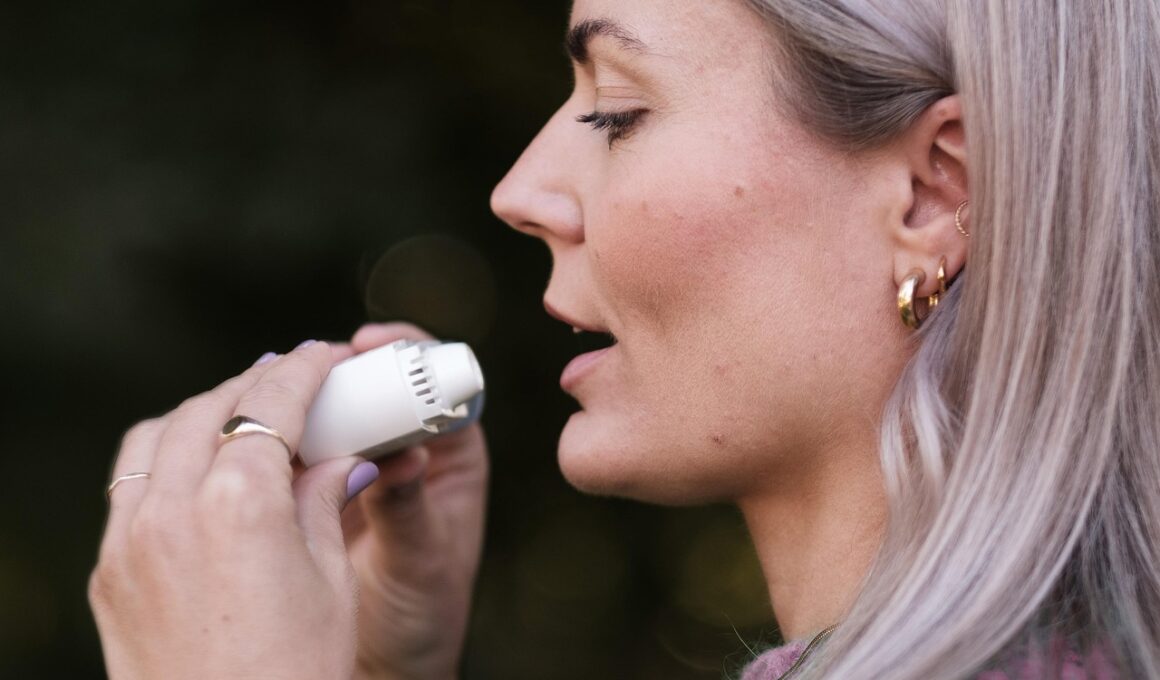Aerobic Exercises to Improve Lung Function in COPD
Chronic Obstructive Pulmonary Disease (COPD) presents numerous challenges for individuals striving to maintain their fitness. Aerobic exercises specifically designed for those with COPD can significantly enhance lung function. Engaging in regular aerobic activity promotes better oxygenation, increases endurance, and leads to an overall improvement in quality of life. Strategies to incorporate aerobic exercises into daily routines are essential in managing COPD symptoms. Activities such as walking, cycling, and swimming are excellent choices that foster cardiovascular fitness. Additionally, low-intensity exercises allow for better control of breathing patterns and promote relaxation. Collaborative programs involving physiotherapists and fitness professionals can provide tailored aerobic activity plans for COPD patients. Monitoring heart rates during exercise ensures safety and effectiveness. Consistency in pursuing these aerobic exercises can yield lasting benefits. Physical activity also aids mental health by reducing anxiety and depression, which are common among COPD patients. Consequently, patients should seek consistent support from healthcare providers to integrate these exercises seamlessly into their lifestyle, making physical activity a vital component in managing chronic obstructive pulmonary disease effectively.
A vital component of any exercise routine for COPD patients is choosing activities that emphasize both enjoyment and sustainability. Walking is a great introductory aerobic exercise; it requires no special equipment and can be done almost anywhere. Swimming is another fantastic option, reducing joint strain while engaging multiple muscle groups. However, it’s essential for patients to listen to their bodies, taking breaks when necessary to avoid overexertion. Incorporating breathing techniques into the exercise, such as pursed-lip breathing, helps to control shortness of breath and enhances lung efficiency. Patients should start with shorter durations and gradually increase as their stamina improves. Joining a group or class can also provide motivation and a sense of camaraderie that encourages regular attendance. Many communities offer programs specifically targeting individuals with chronic conditions. Resources such as the American Lung Association can help guide COPD patients in finding appropriate local resources for fitness. Additionally, incorporating flexibility and strength training exercises into routines enhances overall physical function, directly benefiting daily activities. Virtual resources, such as online videos and fitness apps, can further support this journey, offering a variety of options tailored to individual needs.
Benefits of Aerobic Exercises for COPD
Participating in aerobic exercises brings numerous benefits that specifically address the challenges faced by COPD patients. Among the most significant advantages is enhanced lung capacity. Through regular engagement in aerobic activities, individuals may find it easier to breathe, helping to alleviate symptoms such as dyspnea, or shortness of breath. Improvement in cardiovascular health correlates with better blood circulation and oxygen delivery to muscles, contributing to increased overall energy levels. Consequently, patients often find themselves experiencing fewer flare-ups and hospitalizations. Moreover, engaging in such exercises fosters a sense of independence and accomplishment, as individuals regain control over their health. Improved mood and reduced levels of anxiety and depression are other positive outcomes as physical fitness promotes the release of endorphins. Social interaction can also result from joining community fitness programs, combating feelings of isolation that many COPD patients face. Consistent physical activity serves to reinforce the importance of maintaining a healthy lifestyle overall. Ultimately, aerobic exercises are not merely about improving lung function; they play a crucial role in enhancing both physical and psychological well-being for COPD patients.
Implementing a well-rounded exercise program for a COPD patient involves careful planning and consideration of individual limitations. Before embarking on an aerobic exercise regimen, consulting with a healthcare provider or a physiotherapist specializing in pulmonary rehabilitation is essential. They can tailor a plan that ensures safety and effectiveness. Patients should document their progress and be aware of their body’s responses to various exercises. Keeping a training diary may help track improvements and setbacks, providing valuable insights for future adjustments. Setting realistic goals is crucial; patients should acknowledge that progress may be gradual, and that persistence is key. Balanced workouts incorporating aerobic, strength, and flexibility exercises maximize health benefits. Parents or caregivers can also benefit by participating and encouraging healthy behaviors within families. Moreover, utilizing tools such as pedometers can motivate patients to reach daily activity requirements while also allowing them to track improvements over time. Indoor options, like exercise videos, are excellent substitutes when outdoor workouts may not be feasible. Ultimately, establishing a supportive environment fosters a positive atmosphere for patients to thrive in their fitness journeys.
Precautions When Performing Aerobic Exercises
While aerobic exercise is beneficial for COPD patients, certain precautions must be taken to mitigate risks associated with exercise-induced complications. Patients should ensure they always have a rescue inhaler accessible during workouts. Establishing an appropriate routine involves proper warm-up and cool-down periods to prevent strain or injury. It’s crucial to monitor heart rates and avoid excessive exertion, particularly for those who regularly experience sudden breathlessness. If using outdoor environments, patients should check air quality reports to avoid exercising during high pollution days. This consideration helps reduce exposure to environmental irritants which can exacerbate COPD symptoms. If symptoms worsen during exercise, it’s vital to stop and reassess the activity level. Adequate hydration before, during, and after workouts is essential in maintaining physical well-being, as dehydration can aggravate breathing difficulties. Additionally, clothing choices should be made with comfort and breathability in mind, facilitating greater ease during exercise. Lastly, incorporating rest days within a fixed program is essential for recovery and long-term adherence to a lifestyle that prioritizes physical activity. Utilizing technology such as mobile apps can assist patients in tracking routines and staying motivated.
In conclusion, aerobic exercises play a pivotal role in enhancing lung function and overall well-being for individuals with COPD. Participants not only experience improved respiratory capacity but also enjoy social, emotional, and physical benefits from consistent aerobic activity. The importance of a well-designed exercise program cannot be emphasized enough, as it fosters independence and self-efficacy. Support from healthcare providers is essential in safely navigating exercise protocols and tracking progress. With proper planning and commitment, COPD patients can lead healthier, more active lives by incorporating aerobic exercise effectively. Regular assessments can help adjust exercise intensity and duration to accommodate individual capabilities and fluctuations in health status. Encouragement from family, friends, and fellow patients can also bolster success on this journey. Increasing knowledge about suitable activities is vital in motivating patients towards daily engagement. The rewards of undertaking exercise are abundant—improved outlook, better coping mechanisms, and decreased reliance on medications. The importance of physical activity cannot be understated, as individuals learn to thrive rather than merely survive despite their chronic condition. By prioritizing aerobic fitness, COPD patients can enhance their quality of life while managing their health effectively.
In summary, the incorporation of aerobic exercise in daily routines offers substantial advantages for those battling COPD. The focus on accessible and enjoyable activities empowers individuals to take charge of their health through targeted physical activity. Walking, swimming, and cycling provide diverse options suitable for various fitness levels. By emphasizing not just lung function, but also emotional wellness and social engagement, patients can achieve holistic health improvements. Collaborative efforts with healthcare professionals ensure that exercise programs meet individual needs safely. Regular aerobic activity can lead to fewer hospital visits and a notable reduction in symptom severity, enhancing day-to-day life. Strive for progressive goals while providing reminders about the importance of completing regular warm-ups and cool-downs during workouts. Establish connections with local community resources that facilitate group exercises—the shared experience can elevate motivation. Utilizing technology in tracking fitness progress helps identify challenges and celebrates victories. In all, maintaining a positive attitude and a mindset focused on growth will maximize the benefits of aerobic exercise for COPD patients. With dedication and proper guidance, individuals can experience life enrichment through improved physical skills and emotional resilience.
Ultimately, understanding the significance of aerobic exercises transcends mere physical improvement; it fosters a sense of community and ambition as patients navigate life with COPD. Patients gain invaluable resources and support systems surrounding them as they engage in exercises geared towards enhancing their respiratory functions. The formation of friendships during group activities becomes an essential element in their wellness journey. By continually challenging themselves through various exercises, patients can experience improved lung capacities, elevating overall well-being. Establishing a routine and sticking to it can profoundly impact quality of life, fostering a healthy lifestyle that persists through chronic conditions. Education plays a double role, both informing patients about the best practices in exercising and empowering them to advocate for themselves. Regular follow-ups with healthcare providers ensure safe progression while adapting exercise plans to changing needs. Through steadfast commitment to aerobic routines, individuals can enhance their daily resilience in facing challenges. Achieving even modest gains should be celebrated as they significantly influence the ongoing fight against COPD. Envisioning a healthier future becomes attainable, driven by the determination to embrace regular exercise as an integral part of life.


